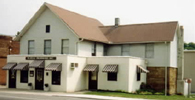I am quoting from
CUMBERLAND COUNTY'S FIRST HUNDRED
YEARS by Helen Bullard and Joseph Marshall Krechniak
(1956).
The Neidringhaus brothers, W.F. and F.G. entered the
land picture in 1893 ... They were associated with Jos. B.
Johnson ... [they] organized as the Cumberland Coal &
Coke Company ... In 1894 they put up a small office
building.
... And that building is the one I am sitting in right
now as I write this.
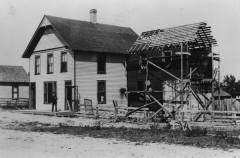
FIRST BUILDING ADDITION
Mr. Lee I. Niedringhaus, grandson of W.F. Niedringhaus,
visited us and gave us photographs – of which this is one
–
and publications he had written. This picture shows the first
addition. It required a new pot-bellied stove for heat.
The base is of hand-hewn (ashlar) blocks of "Crab Orchard
Stone", a sandstone found on the plateau. The new addition had
a vault which is still in use and which still contains some of
the original records.
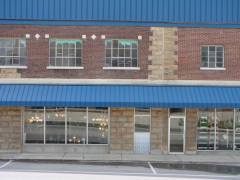
ELMORE BUILDING
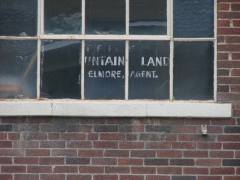
WINDOW CLOSEUP
Lee was also doing research. He mentioned the "Black
Mountain Land Company" and I was surprised when he pointed
out the barely visible sign in a window of a
neighboring building that now houses Wholesale Supply.
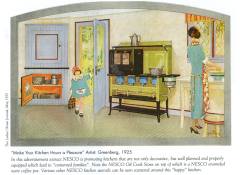
1925 KITCHEN
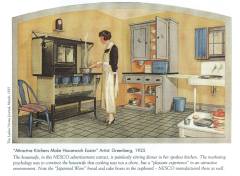
1925 KITCHEN
I find these old Ladies Home Journal ads very interesting.
I swiped them (with permission) from
National Enameling
& Stamping Company, The Early Years 1899-1928 (2005) by
Mr. Niedringhaus. Click the photos to get an enlargement, and
you'll see the "Granite Iron Ware" in the cabinets and on the
stove, the sale of
which provided part of the funds used to invest in Tennessee
property.
Note that the stove burns oil. Of course, there was neither
electricity nor gas. Interestingly, when Mr. Johnson built his
house in Crossville, he plumbed it for gas. There was
a generator out back that dropped carbide into water to generate
acetylene. That house is still standing, and the evidence of
the gas lines remains to some degree. The main post at the base
of the stairs has a hole where the line went to feed the gas
lamp there.
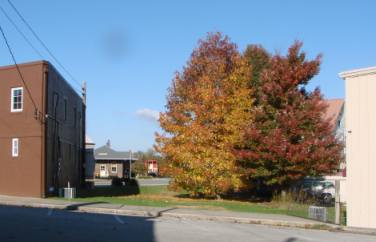
The Missing Train Track
(photo 2010)
The original intent of the Tennessee investments was not to profit from the sale
of property, but rather the sale of coal and timber.
The building was built alongside where the railroad was to be
run. I presume this was to keep a watch on coal cars.
A major trestle was required to pass over a gorge at Ozone, in
east Cumberland County. Much later, that trestle needed
expensive repairs. The railroad simply took up the track
instead of going to that expense and sold the property
the track had occupied. Oops. I don't think that was really in
the county's best interest. Note this photo. In the center is
the depot with a red caboose. The building on the left,
formerly the
Wooden Acorn gift shop, is shaped as a triangle to fit the
corner of the lot left when the train track was still there.
The Plateau Properties building is behind the trees on the
right.
I assume the mineral business was as speculative
and dangerous as it is now. The companies reorganized and
changed hands. The assets were acquired by George E. Harrison,
Sr. and later, the building was acquired from Mr. Black. A
brick front was added. In 1960, the office was organized as
Plateau Properties, Inc. PPI didn't take possession of the
lands, but rather cared for a trust that owns the properties.
The businesses at what is now 118 North Main Street were never
wealthy, but the
sale of land was a more stable business, and PPI contiues
today.
April, 2011
